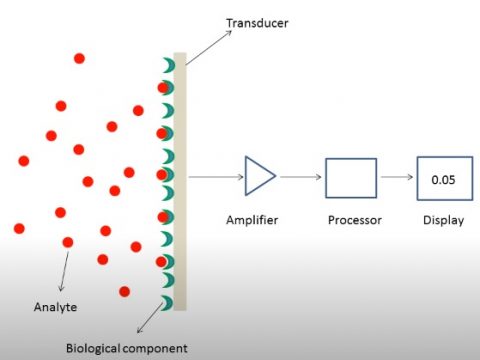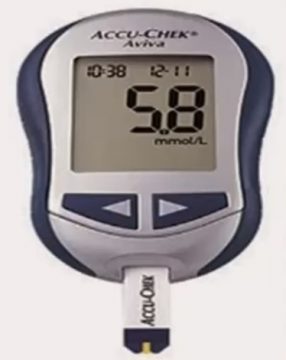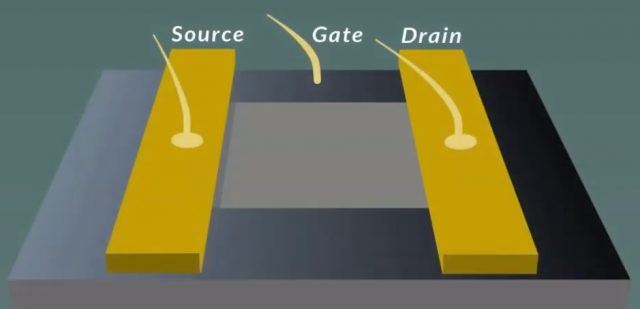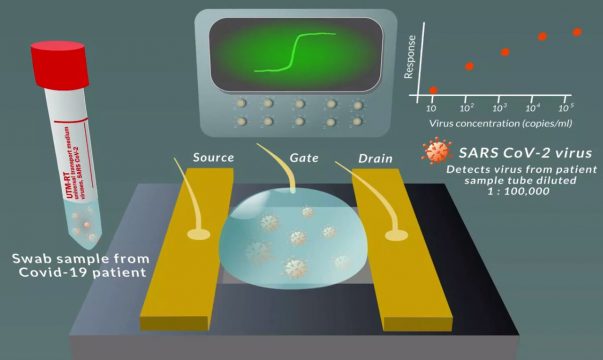Biosensor, Types of Biosensors, and Working of Biosensor
Table of Contents
Biosensor:
The biosensor was first invented by the Leland C. Clerk in 1956 for oxygen detection. Biosensors are analytical devices to measure the concentration of the analyte. For example, we use a glucometer which is biosensor used by the diabetes patients for the measurement of the sugar level in our blood. A molecular biosensor is compact device that measures the specific molecules before informing us about health and disease. The measured molecules are called biomarkers. A biosensor operates on a sample taken from the body for example a drop of blood or it can be worn on or inside the body for giving continuous measurement. The most well known biosensor is glucose sensor which measures the concentration of glucose in the blood or in the skin. This is very helpful for the patients with the diabetes. With a biosensor patients and doctors immediately get the information they need. In order to optimize the treatment reduce unnecessary hospital visits and enables self-management of health and disease.
In the past century we have seen tremendous advances in medicine, the development of antibiotics advances in imaging and diagnosis have fundamentally changed the outcomes for many diseases. In this century we are further accelerating this progress through advances integration in physical sciences along with engineering and life sciences and computing. We have heard about faster more accurate diagnosis that can catch disease earlier. If we think about all sorts of diseases from cancer to heart diseases, antimicrobial resistance infectious diseases these are all areas where early diagnosis of the disease can really help us in how we can treat the patient and with patient survival but also help in stopping outbreaks from spreading.
Working of Biosensor:
A biosensor consists of four major components:
- Molecular recognition process
- Signal generation process
- Disposable sensor device
- Reader instrument
Recognition molecule in the biosensor binds to the biomarkers. The recognition molecules are for example optimist, enzymes or antibodies. The molecular recognition leads to a signal for example an optical electronic or magnetic signal. All this happens inside the disposable sensor device where the molecules come together. Finally the reader instrument measures the signal and translates in to information that is meaningful for the user. There are many diseases and many biomarkers each have different measurement requirements also there are many technological ways how a biosensor can be design.
In biosensors we have biological material like enzymes, antibody, nucleic acid for example RNA or DNA. Biological components are used for the interaction of analyte. When the analyte and biological component will interact then physical or chemical change will be produce which will detected by the transducers. The transducer will convert it in electrical signal which will be further interpreted and converted in to analyte concentration with the help of amplifier and processor and will be show with the help of display.
Types of biosensors:
-
Calorimetric biosensor:
This type of biosensor is used to measures the change in temperature due to either absorption of energy of heat endothermic reaction or due to the release of heat exothermic reaction for example temperature biosensor. The calorimetric sensor is also known as thermometric sensor. Several biological reactions are associated with the release of the heat.
-
Potentiometric biosensor:
This type of biosensor is used to measures the potential difference arising during the redox reaction. e.g urea biosensor. The change in ion concentration is detected by the use of ion selected electrode. The PH electrode is the most used ion selective electrode.
-
Amperometric biosensor:
This type of biosensor is used to measure the current (flow of electrons ) arising during a reaction. e.g. glucose biosensor. Normally a constant voltage will be passes through the electrodes which can be determined a substrate or product will transfer electron with the electro surface to get oxidize or reduce. This will cause the current to flow which can be measured. The current produce is proportional to the substrate concentration.
-
Conductometric biosensor:
This type of biosensor is used to measure the changes in electrical conductivity arising during a reaction. e.g urea biosensor
- Acoustic wave biosensor:
This type of biosensor is used to measures the electric field developed by piezoelectric effects. e.g cocaine biosensor.
-
Optical biosensor:
This type of biosensor is used to measure light arising from the action of the enzyme luciferase which is obtain from fire fly e.g detection of bacteria.
-
Piezoelectric biosensor:
Piezoelectric biosensor is based on acoustics (sound). Piezoelectric biosensor is called acoustic biosensor. Piezoelectric crystals with positive and negative charges vibrate with characteristics frequencies. Adsorption of certain molecules on the crystal surface alters the resonance frequencies which can be measured .
Properties of Good Biosensor:
- It should be highly specific for the analyte
- The response should be linear over the broad substrate range
- The device should be small and biocompatible
- It should be low cost, small and easy to use.
- Assay cost should be lower than conventional tests
- The assay should be fast, reliable and repeatable.
COVID-19 Biosensor:
One of the acute problem we face is the lack of a rapid test to detect SARS COVID the virus that causes COVID-19. The nations that have instituted widespread testing have feared in the current pandemic. They have been able to identify those individuals who have been infected with the virus and track down their close contacts for quarantine. We required an in expensive mass product test for rapid screening. The conventional test for the virus is reverse transcription polymerase chain reaction test. This involves preparation works in the lab to isolate the viral RNA make a DNA copy from the RNA and then make multiple copies of DNA using polymerase chain reaction. From sample collection to result the test usually takes a few hours to a couple of days. This new discovery is very exciting. A group of scientist in the republic of Korea have created a biosensor for SARS-Cov-2. They designed a device that would detect the spike protein which is displayed on the outside of the virus couple. The graphine field effect transistor (GFET) was derviatized with antibodies for the spike of protein. This discovery is a marriage of several disciplines including electronics, nanofabrication, chemistry and virology to address a pressing medical need. The team took advantage of the remarkable electronic properties of graphene.
Now we will discuss how it work the team took advantage of the remarkable electronic properties of graphene. Graphene is a sheet of carbon a single atom thick. Its structure is like an extended network of benzene rings. The freely mobiles electrons in the conjugated pi bonds create a highly conductive material. To construct graphene based transistor the team used established nanofabrication techniques. They used a wet transfer method to deposit graphene on to a silicon dioxide substrate. Channels were formed in the graphene layer using photolithography and reactive ion etching forming orderly patterns of graphene on the substrate.
Then the metal electrodes were added using a thin film deposition and lift off method. In this way graphene bridge the source and drain electrodes. Each transistor measured 100 by 100 microns. At this point the graphene was ready to devertized to make a COVID 19 sensor. The graphene was soaked with a PBASE solution. PBASE is a linker that contains a pyrene group that non covalently attaches to graphene through stacking. At other end is an activated ester which react with amines. Then they added the SARS-Covid-2 spike protein antibody which reacted with the linker to form a chemical bond. After the graphene was derivatized with antibody, they could test their device sensitivity. Their design used a buffered water droplet with an electrode as the transistor gate so called aqueous solution gated FET. Now if a voltage is applied across the source and drain electrodes. A current flow through graphene layer can be measured as a function of the gate voltage. Next they would tested whether their transistor would responds to the spike protein. The spike protein bound to the antibodies with high affinity. This event changes the charge distribution in the immediate vicinity of the graphene layer thus changing it electrical conductivity. This change in the conductivity alters the amount of current that can flow between the source and drain electrodes. They established that their device could detect the spike protein down to 1 femtogram per milliliter a very high sensitivity. Next they tested the response to a related but distinct spike protein from the MERS virus. They found that their sensor had no response to this spike protein establishing that their sensor was specific for COVID-19. They then established that the sensor could detect the whole virus. Their GFET sensor detected concentration as low as 16 PFU per milli liter. A PFU is a unit defining the number of virus particles. They also showed the addition of higher concentration of virus gave a linear increase in response.
To top at all off they took an actual swab sample from a COVID 19 patient and demonstrated that their device could detect the virus. Even if diluted down 100000 fold. The higher the concentration of the virus in the sample the greater signal they saw in their biosensor. They carried out the negative control experiment also:
A swab sample from a healthy uninfected person showed no response. This critical experiment demonstrated proof of the concept that the device could be used to distinguish between healthy and infected person. This method is fast, selective and highly sensitivity. They can detect virus directly from patient swab samples without lengthy sample preparation in the lab. This device has not been approved by the regular agencies for diagnostics use in people yet. A number of validation studies establishing the stability test will need to be carried out first.
Silicon based biosensor for chip for medical diagnosis:
A silicon based biosensor chip for low cast and portable use in health care diagnostics. As we all know that health care cost are sky rocketing and diagnostics is an important friction of it. Almost 1.3 trillion dollars can be saved improvements in prevention so early diagnosis becomes a key. Molecular diagnostics is one of the growing areas of diagnostics. It tries to infer a person health by measuring genetic sequence but current diagnostics methods are very centralized if we wanted to get a test for tuberculosis. We will go to a diagnostic centre where our blood will be drawn it will be preserved, processed and then sent to centralized laboratory and would be analysed by skilled technician using complex optical methods. In other hand if we look at the world of silicon integrated circuits. Moore’s law allows us to pick in the power of a billion transistors in a very small chip. So we can make a really complex systems that are low power, low cost, portable and to be used by inexperienced personal. This biosensor can be used at a point of care in the field in a rural health setting. Access to low cost health care is not just issue in that country. It is an issue across the world to solving it is not just an academic challenge. So the key discovery that makes this possible is the ability to incorporate optical nano structure inside a standard CMOS integrated fabrication. That allows us to remove all the complex optical components and put all the complexities inside the chip. We do not make any changes to the CMOS fabrication process. It is the same process that manufactures the chips in our smartphones and laptops. The chip allows us to analyse and process multiple analytes at the same time and this is extremely crucial for reliable and accurate diagnosis.
So if we dive inside a silicon chip we will see millions of transistor be inter connected in a complex multiple layer network but it turns out of their nano scale dimension. They can simultaneously be used to interact with the optical fields in this particular case filtering the background signal leading to very sensitive detection of the biomolecules. Once the diagnostic technology becomes millimetres sized, low power chip. One can imagine that these would be inside our body taking complex measurements and perhaps relating that information to our phone telling us that how our system is functioning. So the miniature diagnostic device makes portable biosensor and personalized health care a real possibility.




